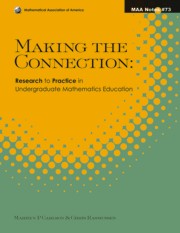Book contents
- Frontmatter
- Preface
- Contents
- Part 1 Student Thinking
- 1a Foundations for Beginning Calculus
- 1 On Developing a Rich Conception of Variable
- 2 Rethinking Change
- 3 Foundational Reasoning Abilities that Promote Coherence in Students' Function Understanding
- 4 The Concept of Accumulation in Calculus
- 1b Infinity, Limit and Divisibility
- 5 Developing Notions of Infinity
- 6 Layers of Abstraction: Theory and Design for the Instruction of Limit Concepts
- 7 Divisibility and Transparency of Number Representations
- 1c Proving Theorems
- 8 Overcoming Students' Difficulties in Learning to Understand and Construct Proofs
- 9 Mathematical Induction: Cognitive and Instructional Considerations
- 10 Proving Starting from Informal Notions of Symmetry and Transformations
- 11 Teaching and Learning Group Theory
- 12 Teaching for Understanding: A Case of Students' Learning to Use the Uniqueness Theorem as a Tool in Differential Equations
- Part 2 Cross-Cutting Themes
- About the Editors
1 - On Developing a Rich Conception of Variable
from 1a - Foundations for Beginning Calculus
- Frontmatter
- Preface
- Contents
- Part 1 Student Thinking
- 1a Foundations for Beginning Calculus
- 1 On Developing a Rich Conception of Variable
- 2 Rethinking Change
- 3 Foundational Reasoning Abilities that Promote Coherence in Students' Function Understanding
- 4 The Concept of Accumulation in Calculus
- 1b Infinity, Limit and Divisibility
- 5 Developing Notions of Infinity
- 6 Layers of Abstraction: Theory and Design for the Instruction of Limit Concepts
- 7 Divisibility and Transparency of Number Representations
- 1c Proving Theorems
- 8 Overcoming Students' Difficulties in Learning to Understand and Construct Proofs
- 9 Mathematical Induction: Cognitive and Instructional Considerations
- 10 Proving Starting from Informal Notions of Symmetry and Transformations
- 11 Teaching and Learning Group Theory
- 12 Teaching for Understanding: A Case of Students' Learning to Use the Uniqueness Theorem as a Tool in Differential Equations
- Part 2 Cross-Cutting Themes
- About the Editors
Summary
Introduction
Have you ever considered that what mathematicians call ‘variable’ is not a mathematically well-defined concept? And that variable can have different meanings in different settings? Unlike the concept of function, for example, variable has no precise mathematical definition. It has come to be a “catch all” term to cover a variety of uses of letters in expressions and equations. As a result, students are often unclear about the different ways letters are used in mathematics.
Later in this chapter, we provide practical suggestions to help students develop a rich conception of variable as called for by the National Council of Teachers of Mathematics (NCTM) in Principles and Standards for School Mathematics (NCTM, 2000). For now, though, let's begin this chapter with some traditional problems that students typically encounter in their high school or college math courses. Work through each problem, and pay attention to the roles that your symbols play during the process of solving them.
Problem 1. Laureen trained for a bicycle race by repeatedly going up and down a hill near her house. Every time she went up the hill, she rode her bike at an average speed of 8 km/h and she rode back down the hill at an average speed of 17 km/h ending at the same spot where she started. One day, she went up and down the hill repeatedly for two and a half hours.
- Type
- Chapter
- Information
- Making the ConnectionResearch and Teaching in Undergraduate Mathematics Education, pp. 3 - 14Publisher: Mathematical Association of AmericaPrint publication year: 2008
- 10
- Cited by

